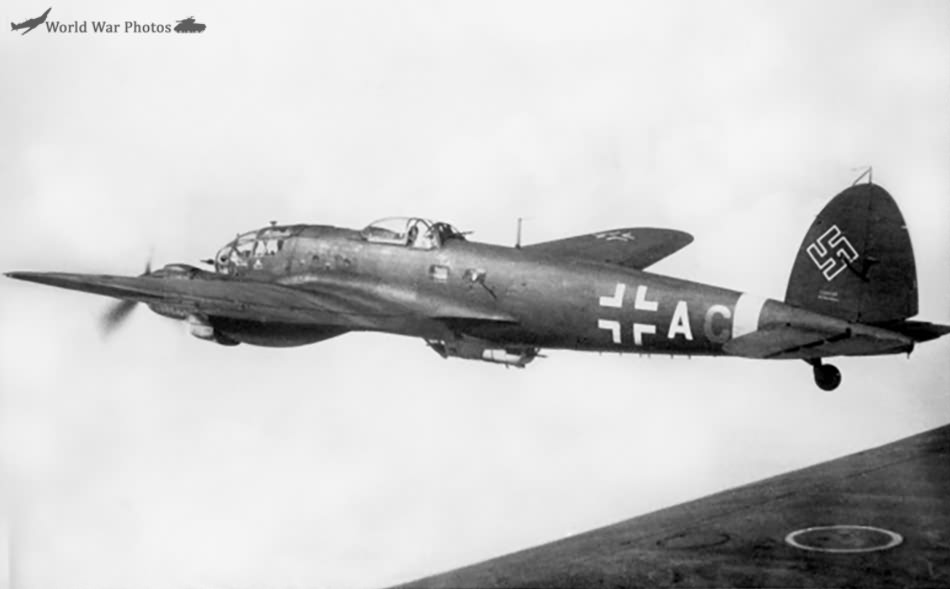The Heinkel He 111H-16 emerged in late 1942 as a crucial evolution of the venerable He 111 bomber, becoming the third large-scale production standard within the H-series. This variant incorporated significant enhancements, particularly in its defensive armament, and would ultimately serve as the last version of the He 111 to be produced in large numbers before the aircraft’s production ceased in autumn 1944.
Technical Specifications and Armament
The He 111H-16 was primarily powered by two Junkers Jumo 211F-2 12-cylinder, liquid-cooled, inline engines, each producing 1,350 hp.
Its key dimensions were:
- Wingspan: 22.5 meters (73 feet 9.8 inches).
- Length: 16.4 meters (53 feet 7.5 inches).
- Height: 4.0 meters (13 feet 1.5 inches).
The aircraft had an empty weight of approximately 9,800 to 9,900 kg (around 21,600-21,800 lbs) and a maximum take-off weight of 14,000 kg (around 30,864 lbs). Performance figures for the H-16 included a maximum speed of 400-425 km/h (249-264 mph) at 6,000 meters and a service ceiling of 6,000-6,700 meters. It also boasted an operational range of 2,000 km.
A critical improvement for the H-16 was its enhanced defensive armament, typically comprising:
- One 13mm Rheinmetall MG 131 machine gun, often mounted in the dorsal position.
- Seven 7.92mm Rheinmetall MG 15 machine guns, strategically placed in the nose, dorsal, beam, and ventral positions.
- One 20mm MG FF machine gun, located in the forward ventral gondola.
This heavier armament, particularly the MG 131, was a direct response to lessons learned in earlier campaigns and was intended to provide better protection against increasingly effective Allied fighter attacks. The H-16 could carry a normal bomb load of 2,000 kg (approx. 4,410 lbs) and a maximum bomb load of 3,000 kg (approx. 6,614 lbs). Some external PVC racks were also available for additional bomb carriage.
Operational Roles and Sub-variants
The He 111H-16 proved to be an exceptionally versatile aircraft, serving in a multitude of roles during the latter stages of World War II. It was considered the main production model for bombing missions but could be readily adapted for various other tasks by fitting different Rüstsätze (standard equipment sets).
Notable roles and specialized variants of the H-16 included:
- Strategic Bomber: He 111H-16s were supplied to units such as KG 53 “Legion Condor” and KG 55 “Greif” for operations on the Eastern Front. New H-16s and H-20s were also supplied to the Auffrischungsstab Ost for intensive training, preparing crews for a dedicated strategic bomber role in Poland.
- Night Operations: The H-16 was extensively used for night bombing, with units like KG 26 employing it in this capacity. During the winter of 1942/43, it even saw service as an improvised night fighter on the Eastern Front, a role for which it was not originally designed, often equipped with FuG 200 radar.
- Glider Tug: Several sub-variants were developed for towing large cargo gliders. These included the He 111H-16/R2 (equipped for rigid bar towing) and the H-16/R3 (which featured additional armor and improved radio guidance). These variants saw action in critical missions, such as the evacuation of Sicily in August 1943.
- Transport and Supply: He 111H-16s played a vital role in critical supply missions, most notably during the Kovel airlift. Here, KG 55 Heinkels were responsible for keeping the encircled “fortified place” supplied by air.
- V-1 Launch Platform Development: The H-16 served as the foundational airframe for the He 111H-22 variant. This specialized modification enabled the aircraft to carry and air-launch one Fi 103 (V-1 flying bomb) against targets such as London. Operations with the H-22 from July 1944 until January 1945 marked the last Heinkel bomber sorties of the air war in the west.
- Further Development: The H-16 also served as the basis for later experimental and production variants, including the He 111H-18 (featuring improved radio equipment and reconnaissance capabilities) and the He 111H-20 series (designed for paratroop transport and night bombing roles). The final H-23 variant was also a direct development of the H-16.
Production of the He 111H-16 began in autumn 1942, with initial deliveries being modest (e.g., one in October 1942, two in November 1942, and three in December 1942), but steadily increased as it became the primary production model. The He 111H-16, with its adaptability and improved capabilities, solidified the He 111’s continued, albeit increasingly challenged, relevance until its production formally ended in late 1944.
